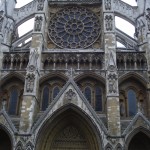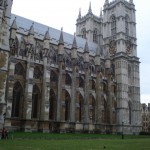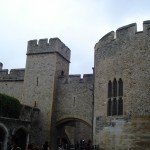September 2nd, 2009 · 1 Comment
Author’s Note: This post was written and live by yesterday at 2:45 PM. Due to systems maintenance back at Dickinson where the servers are, it was mysteriously deleted and all traces ceased to exist on the Internet. Fortunately I managed to find a partial backup of the post with Firefox’s super clutch about:cache utility. Panic attack over.
Okay, so I was the only one who opted out of going to the backstage tour of the National Theatre. Bad call Andrew, bad call. So while I depressively sit in my room waiting for the group to return, I might as well write one big über-post reflecting on the last week or so here in Britain.
To go back a few days, after Stonehenge, we schlepped out to Bath. I experienced some major mixed fellings on the way there. A knowledgeable friend told me that if there is one place to see in the UK, it is Bath. However, it’s a city whose economy is completely reliant on tourism, and I hate tourist traps. The city itself is a sight to be seen. The architecture stands out most clearly, as almost every building within the city limits is built in the Georgian style of the 18th and 19th Centuries.

http://en.wikipedia.org/wiki/Bath,_Somerset
The first landmark we encountered was Bath Abbey, a picturesque Gothic cathedral from the 7th Century. I stood outside and stared at the exterior for a good ten minutes before entering. It is enchanting, imposing, captivating, and just about any other adjective of the sore fathomable. With that in mind, I was thrilled to go inside. The interior was the mixed feelings I had earlier incarnate. The nave itself is gorgeous, featuring high, vaulted ceilings and intricate stained glass windows reminiscent of Westminster. Juxtaposing the ancient architecture, however, were LCD monitors, postcard stands, and any other touristy accoutrement you can imagine. That made me physically sick to the stomach. It is one thing to have a gift shop attached to historical sites, as long as they are distinctly separated. There is nothing wrong with a tourism economy. But just as the Church and the State should be mutually exclusive, so should the site and the shop. A message to the tourism bureau of Bath: NEVER SHIT WHERE YOU EAT. It is not only offensive to the historical purity of the building, but downright sacrilegious to so blatantly mix shopping with as place as important as Bath abbey.
On a related note, The Tower of London wasn’t any better. Maybe we just chose the worst possible time to visit, but it was absolutely stuffed to the gills with sightseers. We forewent seeing the illustrious crown jewels because the queue was longer than the line for Splash Mountain in Disney World. And I’m sure the main attraction isn’t nearly as exciting. To be entirely honest, I didn’t learn much during my time at the Tower. I know that it is very rich historically, serving as a fortress, a prison, a headquarters, and most recently, a kitschy tourist trap. The most best aspect were the enormous ravens hanging out all over the grounds. They made entertaining noises. Not worth the money. (I took the following photographs.)


CAWWW!
Phew. Ranting is cathartic.
Also, I am attempting to embed a slideshow of Bath Abbey into this post, but am failing miserably. I am giving up and posting a link to a slide.com slideshow instead. Click here to view.
Moving on, yesterday was the world famous Notting Hill Carnival, the second largest street festival on the planet. To give the reader a perspective, imagine a crowded rock concert, complete with all the four essential, ubiquitous smells: food, beer, body odor, and ganja. Now take that crowd and spread it out over a twenty square mile radius, but don’t bother thinning out the population density. This year’s attendance figures aren’t live yet, but in past years the event has attracted an upwards of 1.5 million people split over two days, most on Monday, the main event. Since everything else is closed due to the national bank holiday, about an eighth of London’s population has nothing better to do, so why not get a taste of Afro-Caribbean culture and go to Carnival? (When reading, make sure to roll the R in Carnival for dramatic effect). Everywhere I went was in earshot of calypso, reggae, soca, or any other Caribbean-centric music played at rock concert decibel levels. There were more jerk chicken booths than Starbucks in Manhattan. Red Stripe and Corona quenched the throats of everyone, from the lavishly dressed parade people to the pasty white 20-somethings who can’t dance, in attendance just to escape the vanilla routine of Western life (i.e. me). It is definitely worth seeing, but make sure you arrive in the afternoon. We made the mistake of getting there at 10 AM, and were bored for about two hours.
Slideshow attempt #2
On a completely unrelated note, I have been listening to a lot of jazz lately, namely good hard-bop from the early 70s. I listen to a lot of music and it is by far one of my favorite genres, especially when seen live. As a result, I’ve been craving some raw, live jazz, and what better place to experience it than in the cultural center of the UK. I’ve also been considering writing my research paper on the London jazz scene, so it’s probably a good idea to get out there and experience it first hand. My rabid Googling has pointed me to a place called the 606 Club (click the link to see where the club got it’s name). The reviews are pretty glamorous (“London’s best music venue”), so I’m very excited to go in for a cocktail and listen to some great improvisational jazz, or whatever they have playing that evening. If you have never seen good jazz played in person, trust me on this one and come along to see the show. It is truly the best kind of live music around. Skilled musicians can emanate such powerful emotion from their horns, basses, drums, or voices unheard of in rock, hip-hop, or anything else kids today listen to. Definitely worth the £10 or so cover.
That about does it for now. I’m gonna get back to drinking wine alone in my underwear.
Tags: Andrew B
Walking across the Millenium Bridge tonight (well, it was more like jogging to get out stiffness after three hours as a groundling), I was hit by one of those occasional yet profound moments of realization that I was in London. These moments are few and far between, but when you get a moment to step back and look across the Thames and the glowing lights of the city with St. Paul’s dome looming above you, for example, these realizations can hit you like a ton of bricks.
Similar and not unrelated to the “we’re not in Kansas anymore” feelings are the somewhat more frequent instances of understanding the true amount of history behind London and England themselves. In the past few days, I have seen Stonehenge, Roman baths, Medieval cathedrals, prisons, and fortresses, a Shakespeare play, the Jane Austen Centre, the Cabinet War Rooms, and the Tate Modern. The sheer number of years represented by those few landmarks and events is mind-boggling and can serve to disorient the visitor (especially when the visitor comes from a country that’s only approximately 200 years old). I find it interesting to note that I have an almost reverse levels of admiration for the feats and landmarks viewed: I found it utterly astonishing that ancient peoples were able to move stones weighing many tons across empty fields and then arrange them in circular patterns, but I was unimpressed and even disgusted by the artwork of Paul McCarthy digitally projected on a wall with cutting-edge technology at the Tate Modern. I found the stark, bleak nature of the Cabinet War Rooms and the hard work done there to show the strength and resilience of a country under siege, but I found the crown jewels and the grandeur of the monarchy, both past and present, at the Tower of London to be grandiose and over-the-top for a country that is notorious for a “stiff upper lip” and a “keep calm and carry on” sort of mentality.
I suppose what I’m trying to get across is that the sheer nature of hundreds and thousands of years of history (encompassing invasion, multiple great civilizations, and admirable resilience) on a single, small island weighs heavy on a mind that comes from a vast, expansive country with little history at all that can’t even get a healthcare system sorted out. As we now know, you cannot dig down in London without finding something Roman, Medieval, or even prehistoric, yet they still build on and up, layering the present upon the past, and preserving and commemorating as best they can. In my mind, England is a country that seems to be mostly defined by its past, whereas even though America has a shorter history, it seems mostly defined by its present, including its current political standings, fads and trends, and financial influence. London’s ever-changing face and composition always seems to have the same resilient heart, rooted in thousands of years of invasions, shifts in power, influxes of people, devastating disasters, and new technologies, and it appears able to carry on through anything.
Tags: Chelsea · Churches and Cathedrals · Museums
After an early breakfast at the Arran House and a short walk through a light mist back to Trafalgar Square I had a chance to cross some more major sites off my list today. The first of these was Westminster Abbey. The entire class was taken on a thorough tour of the Abbey by John, a knowledgeable, excitable man who made the tour a captivating experience throughout despite the fact that my feet were aching terribly by the end of the two hour experience. Prior to the tour starting I spent a few minutes gazing at the magnificent building from the outside and found myself immediately in awe by both the innate architecture and simply the sheer size of the building. This feeling increased tenfold once we entered. After walking past the courtyard we entered into the nave where I was once again impressed by the beautiful architecture. The tour consisted of a little bit of everything including the tombs of past monarchs, the Grave of the Unknown Warrior and a section dedicated entirely to writers of England. All of these sites caught my attention and stuck with me but my favorite part of the Abbey by far was The Lady Chapel. The many Saints delicately carved into the sides of the room was miraculous. Each one was designed so intricately that even the smallest features were easily discernible. The thing that fascinated me the most inside The Lady Chapel was the Order of the Bath. Each knight in the Order had their own individual flag and seal which they displayed prominently over their seat. Each and every flag was unique and told a different story about the individual that they represent. I found it interesting that knights are sometimes forced to wait a number of years to have their flags displayed because they are required to wait until the person who holds the spot before them passes away before their spot is opened up. After walking through The Lady Chapel I had a sudden urge to design my own flag and copper stall-plate and maybe even start my own Order of the Bath. We will see…
After a pub lunch at the Red Lion, located just a few minutes from the Abbey, Alli, Becca, Chelsea, Kim, Mara, Sarah and I headed to the Tower of London. Heading in with “great expectations” I have to say I was a bit disappointed overall. It was interesting to walk through the ancient monument but I had no idea it would draw the massive number of tourists it did. All ages were represented but I was very surprised to see a large amount of young children walking through the tower, a number of them unaccompanied by adults. The highlight of the Tower of London experience was the Crown Jewel exhibit. After being instructed to put our cameras away we were taken into a room with pressurized doors where we examined crowns that monarchs wore. In addition to the crowns we saw diamond laden rings, sceptors and golden cutlery that made our jaws drop. The most amazing object I observed was a giant punch bowl made entirely out of gold and must have weighed over 18 kilograms. Completely and utterly unbelievable! After the Crown Jewels exhibit my time at the tower went South. Due to the amount of loud, rambunctious children present and a subpar exhibit on torture in the Tower we walked through I was ready to leave after about two hours. Overall my experience was not a completely negative one. Being inside the grounds was breathtaking and the architecture amazed me. However I do not see myself returning here during the rest of my time in London.
After our time in the Tower Alli, Kim, Mara, Sarah and I decided to get an early start on our walking tour project. Since our general theme is parks in London we decided it would be a good idea to visit a couple of the major green spaces in the area. We hopped on the tube and took the central line to St. James Park station. Upon arrival we spent some time moseying around Buckingham Palace and Victoria’s Memorial before getting down to business and taking a stroll through Green and St. James Park. Nothing too exciting was going on at Green Park. At one point we sat down in light green lawn chairs only to be told that we had to pay a fee in order to sit. We quickly dismissed Green Park as a space that we would focus our project on. St. James however was a different story. We immediately spotted water and wandered over where we discovered a multitude of birds including ducks, geese and pigeons. These birds were not afraid to come close to humans at all and we saw many eating out of the hands of children who were offering them bread despite the numerous signs that clearly read “don’t feed the birds”. We wandered through most of the park, passing beautiful lush flower gardens along the way. Overall St. James seemed more alive then Green Park and we definitely plan on heading back to take another look when the Park Office is open and we can receive more information about it’s history.
Today was a very rewarding day overall. I am happy to say that I was able to visit some of the most historic places in the country in one day and ecstatic that my experience at Westminster Abbey went so positively. I’m amazed at just how much I have been able to see in one week here and I know that I continue to see more and more incredible places during my time here in London. Next up: Stonehenge!
Tags: Churches and Cathedrals · Henry
Sometimes I wonder why I didn’t start a major in social anthropology: I’m utterly fascinated by the tiny, perhaps insignificant intricacies of the way people live in Britain today. What interests me most is not necessarily the greater consequences of large immigrant populations or the history of the development of the city, but the subtle differences between British and American dialects of English and the life of a British school child.
After touring Westminster Abbey and the Tower of London today, I found myself wondering about the contemporary relationship between the British population and the Royal Family and nobles. From what I can gather, the main function of the Royal Family these days is to supply the tabloid newspapers with more scandals and fashion reports, and the real importance of the monarchy remains in the past. However, the fact that the monarchy doesn’t have any political role these days doesn’t keep the pomp and circumstance in check: there were millions of pounds of jewels and gold in the Tower of London which are still used today for official ceremonies. Of course, many of these jewels are from an earlier time, so it’s not as if there are thousands of British taxpayer pounds put into a Royal jewelry fund each year (I assume), though I do wonder what the average Brit thinks of all this formality that seems merely left over from an earlier time. Stereotypically, the Brits seem to have a reputation of being reserved, and the behavior I can see on the Tube, for example, confirms this. Yet the tremendous amount of money, glitz, commemoration, and ceremony put into these old traditions doesn’t seem to equate to the British stereotype. Every case in the Tower of London Jewel House sparkled and every inch of the wall and floor of Westminster Abbey was covered with inscriptions and monuments to royals, nobles, and academics passed. The British seem to like their preservation of history, which is all well and good, but I wonder about the origins of their apparent love of ceremony and honor as well, and how these traditions from ages past fit into the lives and minds of contemporary Londoners.
Tags: Chelsea · Churches and Cathedrals · Museums
 On Aug. 20, 2009 we got on the Tube at the Goodge St. station. We took the Northern line to Embankment where we switched lines and headed toward District. We got off at Tower Hill. In total this trip took about 30 minutes.
On Aug. 20, 2009 we got on the Tube at the Goodge St. station. We took the Northern line to Embankment where we switched lines and headed toward District. We got off at Tower Hill. In total this trip took about 30 minutes.
The moment we exited the station we saw the Tower of London across the street. Before heading over to the Tower of London we explored a Memorial to the sailors who died in WWI and WWII. Then we wandered across the street to the Tower. The fist thing we noticed was that it was a very touristy area that drew in people from all over the world. After walking around a bit we saw the Tower bridge and decided to cross it. As we did this we noticed the juxtaposition between the very old bridge and the surrounding modern structure. We also noticed that both the Tower of London and the Tower bridge were covered in scaffolding.
After that we spent an hour trying negotiate a way back to the hotel by bus. Three hours later we arrived back at the Arran House, after being very lost and separated.
Tags: Uncategorized








 On Aug. 20, 2009 we got on the Tube at the Goodge St. station. We took the Northern line to Embankment where we switched lines and headed toward District. We got off at Tower Hill. In total this trip took about 30 minutes.
On Aug. 20, 2009 we got on the Tube at the Goodge St. station. We took the Northern line to Embankment where we switched lines and headed toward District. We got off at Tower Hill. In total this trip took about 30 minutes.